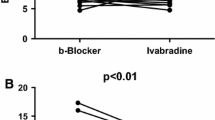Summary
In order to evaluate the hemodynamic effects of long-term oral nisoldipine in patients with impaired left ventricular function, a double-blind, randomized trial was conducted at the Thoraxcenter. Included were patients with severe left ventricular function limitation caused by ischemic heart disease or cardiomyopathy (ejection fraction less than 0.40); exercise capacity was limited by dyspnea or fatigue, not by angina pectoris. Excluded from the trial were patients with obstructive valvular disease, hypertension, or a recent myocardial infarction.
In all patients vasodilator therapy was discontinued. Treatment with digoxin and diuretics was kept constant. At baseline the following data were recorded: exercise capacity in supine position, pulmonary pressures, cardiac outputs, and MUGA ejection fractions at rest and during exercise. After this the patients were randomized for nisoldipine or placebo. The initial dose of nisoldipine of 20 mg daily during 2 weeks was doubled to 40 mg daily for the following 3 weeks.
None of the patients (at the time 16) was lost during the trial because of intolerance or side effects of the test medication. After 5 weeks of treatment, all measurements were repeated.
Interim analysis of the data obtained in the first 12 patients shows similar results in both groups with respect to clinical status, maximal workload attained, heart rate at rest and during exercise, left ventricular filling pressure at rest and during exercise, cardiac output at rest and during exercise, systolic pulmonary artery pressure at rest and during exercise, and increase of rate pressure product. The ejection fraction seems increased in the nisoldipine group at the maximum workload as compared with the ejection fraction measured at the maximum workload in the placebo group.
The preliminary conclusions of the interim analysis are that in these patients with severely impaired left ventricular function nisoldipine was tolerated well, and the negative inotropic effects of nisoldipine — if present — seem very limited and do not prohibit the use of this medication. No functional benefit could be obtained with nisoldipine, but the number of participants here is small.
Preview
Unable to display preview. Download preview PDF.
Similar content being viewed by others
Editor information
Editors and Affiliations
Rights and permissions
Copyright information
© 1987 Springer-Verlag Berlin Heidelberg
About this paper
Cite this paper
Geuskens, R., Kint, P.P., Laird-Meeter, K., Hugenholtz, P.G. (1987). Hemodynamic Effects of Long-Term Oral Nisoldipine Versus Placebo in Patients with Impaired Ventricular Function. In: Hugenholtz, P.G., Meyer, J. (eds) Nisoldipine 1987. Springer, Berlin, Heidelberg. https://doi.org/10.1007/978-3-642-73010-8_26
Download citation
DOI: https://doi.org/10.1007/978-3-642-73010-8_26
Publisher Name: Springer, Berlin, Heidelberg
Print ISBN: 978-3-540-18394-5
Online ISBN: 978-3-642-73010-8
eBook Packages: Springer Book Archive




